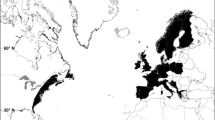Abstract
The parasites of ten fish species, including four Gobiidae, three Gasterosteidae, two Syngnathidae, and one Zoarcidae from the Salzhaff region, Northwest Mecklenburg, Baltic Sea, were investigated in 1995 and 1996. As many as 36 parasite species, represented by diverse groups of helminths and protozoans as well as annelids and copepods, are found during 4 seasons in these hosts. By far the most abundant group is represented by digeneans, comprising 15 species, followed by 7 cestodans and 6 nematodes. With regard to component communities, 8 host-parasite combinations are core and secondary species with more than 40% prevalence in which generalists such as the digeneans Podocotyle atomon and Cryptocotyle concavum (in 3 hosts). C. lingua, Diplostomum spathaceum, and Acanthostomum balthicum, and the nematode Hysterothylacium are involved. Also, specialists such as Aphalloides timmi in Pomatoschistus microps as well as Magnibursatus caudofilamentosa and Thersitina gasterostei in Gasterosteus aculeatus attain high levels of prevalence. A comparison of different investigations reveals greater prevalence of allogenic and autogenic parasite species with 3 host cycles in the Rerik-Riff (free Baltic) and higher levels of prevalence of autogenic parasite species with 1 or 2 host cycles in the entire Salzhaff. The component communities of gobies from Dahmeshöved, Lübeck Bight, attain generally lower degrees of prevalence than those of the Salzhaff region. The infracommunities consist mostly of 1–3 parasite species per host specimen; this value is surpassed on occasion in P. microps (maximum 7 species) and in G. aculeatus (maximum 9 species, which may compete for 5 microhabitats in a host specimen). In this context the theory of empty niches propagated by some parasitologists is critically discussed and substituted by the assumption of variable niche widths. The seasonality of the more abundant parasites is either unclear – as in the case of C. concavum– or evident – as in the case of P. atomon, which prevail in early spring and summer, or A. timmi, which dominate in late summer, as do M. caudofilamentosa, which is absent in spring. The main causes of the infestation of fish hosts may be their ages and the availability of parasites due to the presence of intermediate hosts.
Similar content being viewed by others
Author information
Authors and Affiliations
Additional information
Received: 27 October 1998 / Accepted: 5 November 1998
Rights and permissions
About this article
Cite this article
Zander, C., Reimer, L. & Barz, K. Parasite communities of the Salzhaff (Northwest Mecklenburg, Baltic Sea). I. Structure and dynamics of communities of littoral fish, especially small-sized fish. Parasitol Res 85, 356–372 (1999). https://doi.org/10.1007/s004360050562
Issue Date:
DOI: https://doi.org/10.1007/s004360050562




